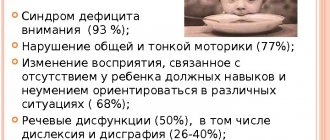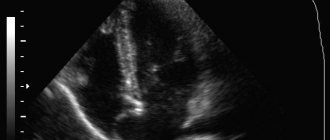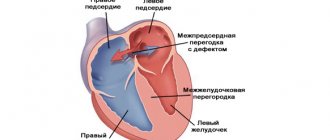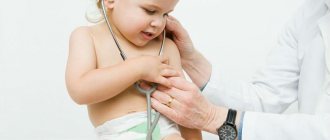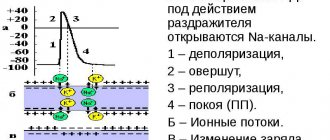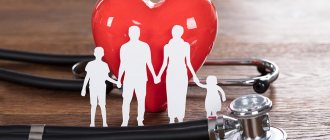Atrial septal defect is a developmental abnormality of the heart. Its main feature is an opening in the wall that divides the atria into two separate chambers. As a result, there is an excessive load on the pulmonary circulation.
Improper treatment of atrial septal defect in children or its absence worsens well-being; in complex cases, death is possible.
Medical staff provide assistance for diseases of the cardiovascular system, including congenital defects. For this purpose, doctors use modern instruments and devices, guided by the latest scientific recommendations, schemes and protocols. This explains the high efficiency of the treatment process.
Causes of aneurysm in children
A cardiac aneurysm in a child occurs for a variety of reasons. The disease can be congenital or appear during the development of the child. Often the genetic predisposition of children leads to the development of pathology.
The following pathologies lead to a decrease in the elasticity of vascular walls:
- high blood pressure;
- chronic atherosclerosis;
- vasculitis;
- syphilis and sexually transmitted diseases.
Smoking in adolescence also becomes a serious risk factor. Such a bad habit leads to the accelerated development of an aneurysm, which becomes the main cause of hypertension. Blood clots and injuries to small vessels also lead to the disease. Pathologies quite often occur in adolescents who are involved in road accidents, emergencies, or engage in extreme sports.
The stages of aneurysm in children are closely related to the different stages of the ongoing impairment of the heart’s capabilities:
- stage of compensation, which is observed with a fairly stable size of the resulting aneurysm or with its slow growth. In these cases, the load on the organ increases slightly, which ultimately allows it to function within acceptable limits;
- the stage of decompensation is noted with a rapidly growing pathology with impaired contractile function of the heart. As a result, the organ stops normally releasing the required volume of blood into the circulatory system, which leads to complications.
Features of pathology in a newborn
An aneurysm of the interatrial septum in a newborn is primarily manifested by a slight cyanosis of the skin. Other symptoms appear in a child at the age of 3-4 months. The final diagnosis can be made for the patient when he reaches 2 years of age. The small size of the cardiac vessel defect does not cause symptoms, so the disease can only be determined through diagnosis.
As the defect enlarges and becomes larger than 15 mm, an aneurysm of the sac in a newborn may be accompanied by the following symptoms:
- Retarded physical development. The patient may experience weight loss and delayed psychomotor development.
- A decrease in the body's defenses, which causes frequent viral diseases.
- Pathological protrusion of the heart, which can be determined by palpation.
Symptoms of aneurysm in children
Aneurysm in children is practically asymptomatic for many years and is most often detected after an X-ray examination performed to determine another disease. Pain in the pathological area can also become a symptom of the disease.
Congenital or acquired cardiac aneurysm can have a variety of forms, and each of them has certain characteristic symptoms.
- Abnormal areas in the brain lead to difficulties with normal blood flow and activity of this organ, problems with movement, severe headaches and sudden epileptic seizures. As a result, the mortality rate ranges from 10 to 30%.
- A cardiac aneurysm in a child most often occurs at the stage of intrauterine development. A serious symptom of the pathology is the presence of various signs of insufficient heart function due to a protruding, thinned and non-functioning heart wall.
- Aortic aneurysm is almost always completely asymptomatic or, in advanced forms, manifests itself in the form of coughing and incipient shortness of breath due to compression of the trachea and bronchi, severe pain in the back and during the process of swallowing. When an aortic aneurysm ruptures, immediate death almost always occurs.
- Pathological areas of the aorta located in the peritoneal cavity. With this type of aneurysm, the child feels pain in the abdomen, chest and lower back, and in some positions the discomfort intensifies.
A serious symptom of interatrial aneurysm in children is the appearance of a palpable pulsation in the abdominal cavity, increased body temperature, noticeable blueness of the fingertips and severe weight loss. Basically, the signs of this terrible disease appear with inflammation and the appearance of blood clots.
When a cardiac aneurysm suddenly ruptures, a child experiences severe acute pain in the chest, a drop in blood pressure, a strong increase in heart rate and disruption of the breathing process, the absence of any reaction to painful stimuli and noticeable bluish skin. If an aneurysm ruptures and there is no timely necessary medical care, the child dies.
When should you see a doctor?
A visit to a pediatric cardiologist, pediatrician, and vascular surgeon is recommended if you have the following signs of an aneurysm in children:
- frequent and severe headaches in a child;
- a feeling of discomfort and unpleasant sensations in the chest;
- periodic loss of consciousness and frequent dizziness;
- shortness of breath even with mild physical exertion;
- pallor and some swelling of the skin.
An experienced pediatric cardiologist at Meditsina JSC (academician Roitberg’s clinic), located in the central district of Moscow, will carefully examine the child and record all his complaints. The specialist will talk with the parents and carefully study the provided medical documents. Based on the results, the necessary studies will be prescribed and appropriate treatment procedures will be carried out.
Diagnosis of aneurysms
In some cases, pathology can be suspected when examined by a doctor. Next, a series of studies are prescribed to find the problem and assess its scale:
- chest x-ray;
- Ultrasound of the heart, Dopplerography of the thoracic and abdominal aorta, neurosonography;
- CT scan;
- angiography ー X-ray examination with preliminary introduction of a contrast agent into the vessel.
Complications of aneurysm in children
The main and most dangerous complication of an aneurysm in children is rupture of its wall, which leads to threatening internal bleeding. The large size of this pathology leads to a high risk of its development, and the consequences can be very severe, including death.
After rupture of the pathological area, the child may fall into a coma due to blood entering the existing subarachnoid space and mixing with the spinal cord fluid.
Another possible complication of an aneurysm is the risk of the formation of small blood clots in the form of thrombi, which are carried through the bloodstream and block the lumen of numerous small blood vessels. This leads to disruption of the blood supply to various internal organs, which may be the lower limbs, kidneys or organs located in the abdominal cavity. In most cases, patients die while still preparing for the upcoming operation.
Sudden vasospasm is the main cause of stroke and death. The patient's disability becomes a completely favorable outcome.
How to get treatment in Israel
When deciding on treatment in Israel, a patient with developmental defects of internal organs, including the interatrial septum, receives many advantages, including the use of the latest scientific recommendations and innovative equipment, reasonable cost, rapid recovery of operated children.
Thanks to the coordinated work of specialists from different fields, surgeons cope with pathology even in very complex cases. Ignorance of the language will not become an obstacle to communication - each patient is accompanied by a Russian-speaking consultant.
To get into Hadassah, you need to fill out an electronic application. An employee of the international department will contact you, provide the necessary information and answer additional questions. By using our services, you will not have to overpay to intermediaries - all payments are made only to the cash desk of the medical center before hospitalization.
Diagnosis and treatment of aneurysm in children
Based on the symptoms, an accurate diagnosis of an aneurysm in a small child is almost impossible. All types of necessary examinations are prescribed only by a qualified doctor. With the help of differential diagnostics, a specialist can distinguish an aneurysm from various tumor neoplasms, which often have a threatening oncological nature.
At JSC “Medicine” (clinic of academician Roitberg), after a conversation with the parents, examination of the child and recording of his complaints, the pediatric cardiologist will prescribe the following types of tests for the child:
- echocardiography, ECHO-CG, daily ECG monitoring;
- ultrasound examination of joints;
- MRI and radiography;
- performing joint puncture;
- various laboratory tests.
To treat aneurysms, the clinic uses only high-quality medications and effective modern techniques. The experience and professionalism of doctors allows children to return health and joy of life.
Parents must pay close attention to the health of their child and regularly examine him with various medical specialists. This approach contributes to timely prevention and detection of the presence of this terrible disease.
Treatment of an aneurysm directly depends on the speed of development of this pathology. With rapid progression and large size of the affected area, competent surgical intervention is performed and its replacement with an artificial graft. Heart surgery in children is performed in a hospital, where the necessary modern equipment is available for careful monitoring of the child’s health condition and devices for the successful performance of the upcoming surgical intervention.
Most often, surgical intervention is performed as planned, and more rarely - as an emergency procedure. Before the operation and after it is performed, the patient must be under the supervision of an experienced cardiac surgeon or pediatrician while being registered at the dispensary.
Conservative methods are used to treat a small aneurysm. In this case, medications are prescribed that lower blood pressure and reduce the load on the walls of blood vessels. After surgery to relieve this pathology, the child’s condition is regularly monitored and a doctor is visited.
Treatment
Drug treatment
The issue of treating an aneurysm is a pressing topic that worries many. To date, the principles of treatment of aneurysm and other minor cardiac anomalies have not been fully determined. However, the following management tactics for such patients can be suggested:
- Drug treatment. In this case, medications may be prescribed that normalize metabolism in the connective tissue.
- Prescription of magnesium preparations. Recently, its role in the processes of proper formation of collagen fibers has been proven. At the same time, magnesium itself is part of connective tissue. The effectiveness of magnesium preparations has also been proven in relation to its antiarrhythmic effect. By participating in the processes of excitation of the heart cell, magnesium contributes to the proper functioning of the heart in the processes of contraction and relaxation. Therefore, it can be prescribed if it is necessary to treat rhythm disturbances.
- Vitamins of group B and PP. The drugs improve metabolism in connective tissue.
- Timely antibacterial treatment of infectious diseases.
- Non-drug treatment. It is as follows:
Baby massage
- Proper organization of the child’s work and rest schedule. Excessive physical activity is excluded, normal and complete rest is ensured.
It is recommended to follow a daily routine.
- Healthy and balanced diet.
- Hydrotherapy is the use of medicinal baths.
- Balneotherapy - treatment with mineral baths.
- Various types of massage, including manual, underwater, etc.
- Physiotherapeutic procedures, including electrophoresis with magnesium.
- Physical therapy classes.
The treatment program is individual for each patient. It is based on a comprehensive health assessment, which includes various diagnostic methods.
Surgical treatment is not performed, since an aneurysm is not a defect, but belongs to the group of minor anomalies in the development of the heart. Therefore, it does not interfere with the functioning of the heart.
Minor cardiac anomalies are a group of conditions that require the patient to be registered. Therefore, it is necessary to regularly see a specialist. Observation is carried out to monitor the condition of the aneurysm and correct treatment methods, if necessary.
Prevention of aneurysm in children
With a congenital aneurysm, preventive measures are pointless, but such a disease can be prevented. Teenagers should never smoke, as this habit has a detrimental effect on the condition of the heart and blood vessels. If you have problems with blood pressure, constant monitoring is recommended.
The child's diet should be balanced and consist of healthy foods. Dishes with trans fats and semi-finished products are excluded from the diet, and the amount of sweets is reduced. The diet should consist of vegetables, fruits and unrefined carbohydrates.
The child should regularly engage in physical education or sports activities. Excess weight negatively affects the condition of the heart and blood vessels, so if such a problem arises, it is recommended to review the child’s diet. The teenager's height and weight should progress proportionally. To prevent aneurysm, children and adolescents should sleep at least 7 hours a day and, if possible, avoid stressful situations.
How to make an appointment with a specialist?
JSC "Medicine" (clinic of academician Roitberg) is located in the center of Moscow in the Central Administrative District at the address: 2nd Tverskoy-Yamskaya lane, building 10 (Mayakovskaya metro station).
Our medical center employs doctors of the highest qualifications and extensive experience. All diagnostic measures are carried out with maximum efficiency. Especially when it comes to emergencies. All procedures are carried out on modern equipment using the latest technologies.
Doctors, having received the examination results, prescribe the optimal treatment method, which will be aimed exclusively at a positive result. Patients are always under the strict supervision of doctors. This allows you to quickly react if the child’s condition worsens.
If you have questions, you can make an appointment by phone.

